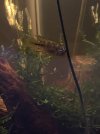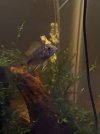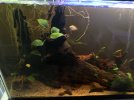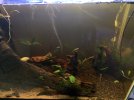About 3 weeks ago I got a solo male A. Borellii sp. Opal. I had him in a QT tank with other fish while I finished building an upgraded 32 gallon tank for my community for 1 week. During this time he was colored up and seemed great. Once I moved them all to the new tank, he has had no color and has significant dark vertical stripes.
He swims around fine, acts normal and curious. He is eating regularly and there has been no issues I've witnessed getting along with other fish. The tank has natural sand and dark rounded pebbles, lots of driftwood with multiple caves and hiding spots. It's moderately planted with Anubias and Crypts with terrestrial plants growing out the top, with their extensive root systems filling a good 1/4 of the left side of the tank along with floating Frogbit covering about 1/3 of surface currently. It also has a Catappa Leaf and Alder cone to add tannins, between these and the driftwood it is decently staining the water. Lighting is also low due to not having strong lights and the floating plants and dark water blocking a lot of it.
Tank mates include 1 male and 2 female Honey Gourami, 6 Ember Tetras and 6 Pygmy Corydoras, a handful of Blue Jelly Neos and a Ramshorn snail. They basically all ignore each other and don't seem to mind at all when anyone else is around them aside from the Honey interacting with each other and the light shoaling of the little guys.
Temp 76-79F. Ph is around 6.7 with Ammonia 0 Nitrite 0 and Nitrate nearly 0 but am regularly dosing Flourish. Since most media was transferred from the previous tank I had, I didn't wait to cycle since I moved it over but did dose Stability daily for the first week to help with the adjustment to the larger tank. I have tested water daily and seen no trace of any Ammonia or Nitrite. I've done one water change with the next one happening tomorrow.
After 2 weeks in the new tank I thought he would have settled by now. Everyone else seems very happy and enjoying the setup. I created it specifically intending to have components that each species likes so they would feel comfortable. A couple days ago I started dosing StressGuard to try to help him out but haven't seen a difference yet. I'm just not sure what else to do to help him.
He swims around fine, acts normal and curious. He is eating regularly and there has been no issues I've witnessed getting along with other fish. The tank has natural sand and dark rounded pebbles, lots of driftwood with multiple caves and hiding spots. It's moderately planted with Anubias and Crypts with terrestrial plants growing out the top, with their extensive root systems filling a good 1/4 of the left side of the tank along with floating Frogbit covering about 1/3 of surface currently. It also has a Catappa Leaf and Alder cone to add tannins, between these and the driftwood it is decently staining the water. Lighting is also low due to not having strong lights and the floating plants and dark water blocking a lot of it.
Tank mates include 1 male and 2 female Honey Gourami, 6 Ember Tetras and 6 Pygmy Corydoras, a handful of Blue Jelly Neos and a Ramshorn snail. They basically all ignore each other and don't seem to mind at all when anyone else is around them aside from the Honey interacting with each other and the light shoaling of the little guys.
Temp 76-79F. Ph is around 6.7 with Ammonia 0 Nitrite 0 and Nitrate nearly 0 but am regularly dosing Flourish. Since most media was transferred from the previous tank I had, I didn't wait to cycle since I moved it over but did dose Stability daily for the first week to help with the adjustment to the larger tank. I have tested water daily and seen no trace of any Ammonia or Nitrite. I've done one water change with the next one happening tomorrow.
After 2 weeks in the new tank I thought he would have settled by now. Everyone else seems very happy and enjoying the setup. I created it specifically intending to have components that each species likes so they would feel comfortable. A couple days ago I started dosing StressGuard to try to help him out but haven't seen a difference yet. I'm just not sure what else to do to help him.







